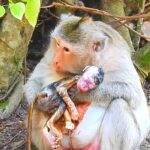In the dense canopy of a Southeast Asian forest, a scene of quiet tragedy recently unfolded — a mother monkey’s heartfelt attempt to bring new life into the world ended in sorrow. Wildlife observers witnessed the emotional ordeal, reminding us once again how deeply animals can feel, grieve, and love.
The mother, a macaque, had been pregnant and visibly preparing for the arrival of her baby. In the days leading up to the birth, she had become more withdrawn from her troop, spending hours grooming herself, building a nest of leaves, and moving more cautiously through the trees. Macaques, known for their intelligence and tight social bonds, often exhibit clear maternal behaviors long before birth. Her instinct to protect and nurture was obvious.
But when the moment came, something went wrong.
The labor was long and difficult. Unlike the typically swift and quiet births in the wild, this one was marked by clear signs of distress. The mother was seen grimacing, clutching at branches for support, and emitting low, mournful cries. As the hours passed, it became increasingly evident that the delivery was not going smoothly. With no way for humans to intervene without risking chaos among the troop or causing her further stress, onlookers were forced to let nature take its course.
Eventually, she gave birth — but the baby did not move. It had been stillborn.
What followed was a heartbreaking display of maternal grief. The mother clutched the lifeless infant tightly to her chest, grooming it gently, as if trying to will it back to life. She carried it with her for hours, even days, refusing to let go. Other members of the troop approached cautiously, some touching her gently or inspecting the baby with curiosity. But none tried to take it from her.

Such behavior has been documented before in primates. Grief in monkeys, particularly mothers who lose their young, has long been a subject of study and fascination among scientists and animal lovers alike. The mourning process can last for days or even weeks, and in some cases, mothers have been observed carrying deceased infants until they begin to decay, unable or unwilling to face the finality of the loss.
This particular mother’s anguish was clear. Her pain was not just physical, but deeply emotional — a raw, visible expression of loss that crossed the barrier between species. It served as a powerful reminder that the bonds of love, especially between a parent and child, are not exclusive to humans.
Eventually, when the time came, she laid the baby down beneath a quiet tree and walked away slowly, casting one last glance before rejoining her troop. Her walk was heavy, her movements slower, her spirit visibly dimmed.
Nature can be breathtakingly beautiful, but also unspeakably cruel. In this mother macaque’s silent mourning, we are reminded of the fragile line between life and loss — and the universal pain of saying goodbye before getting the chance to say hello.
